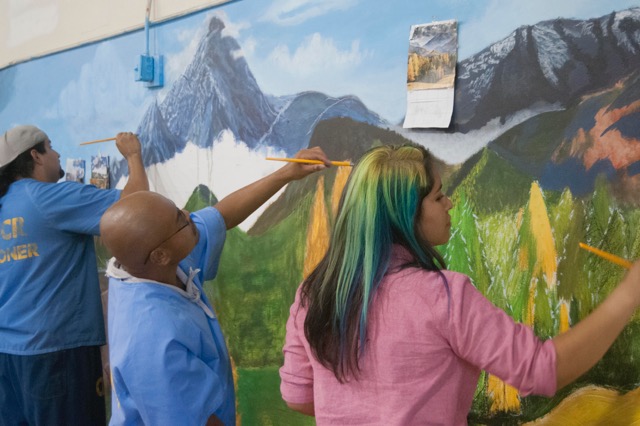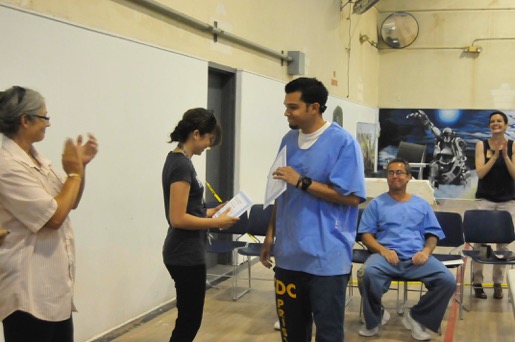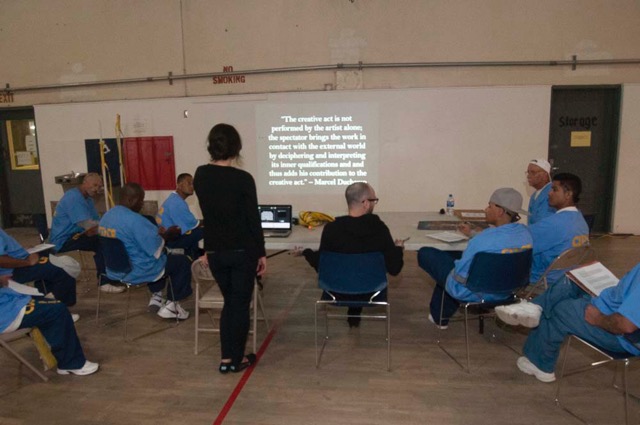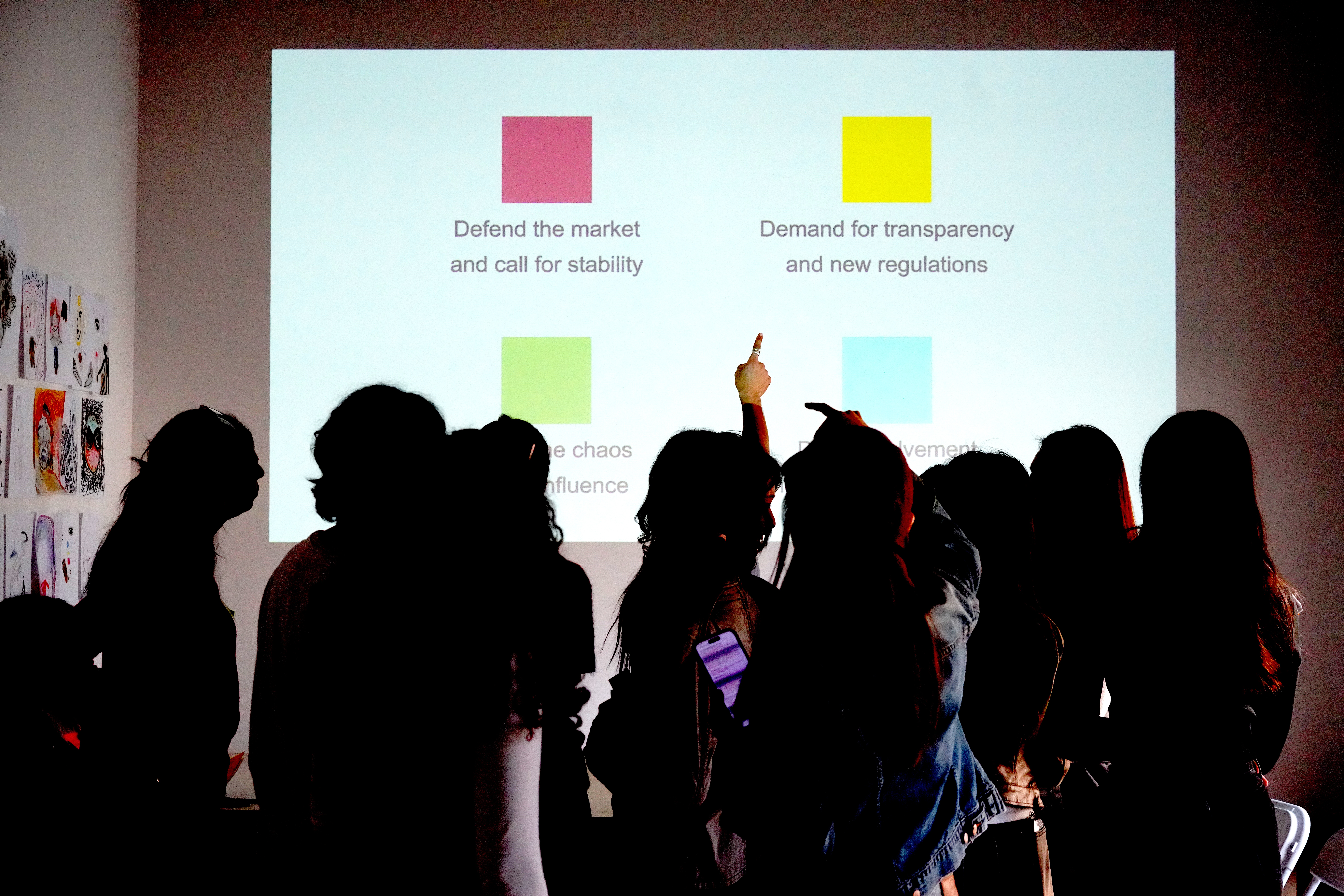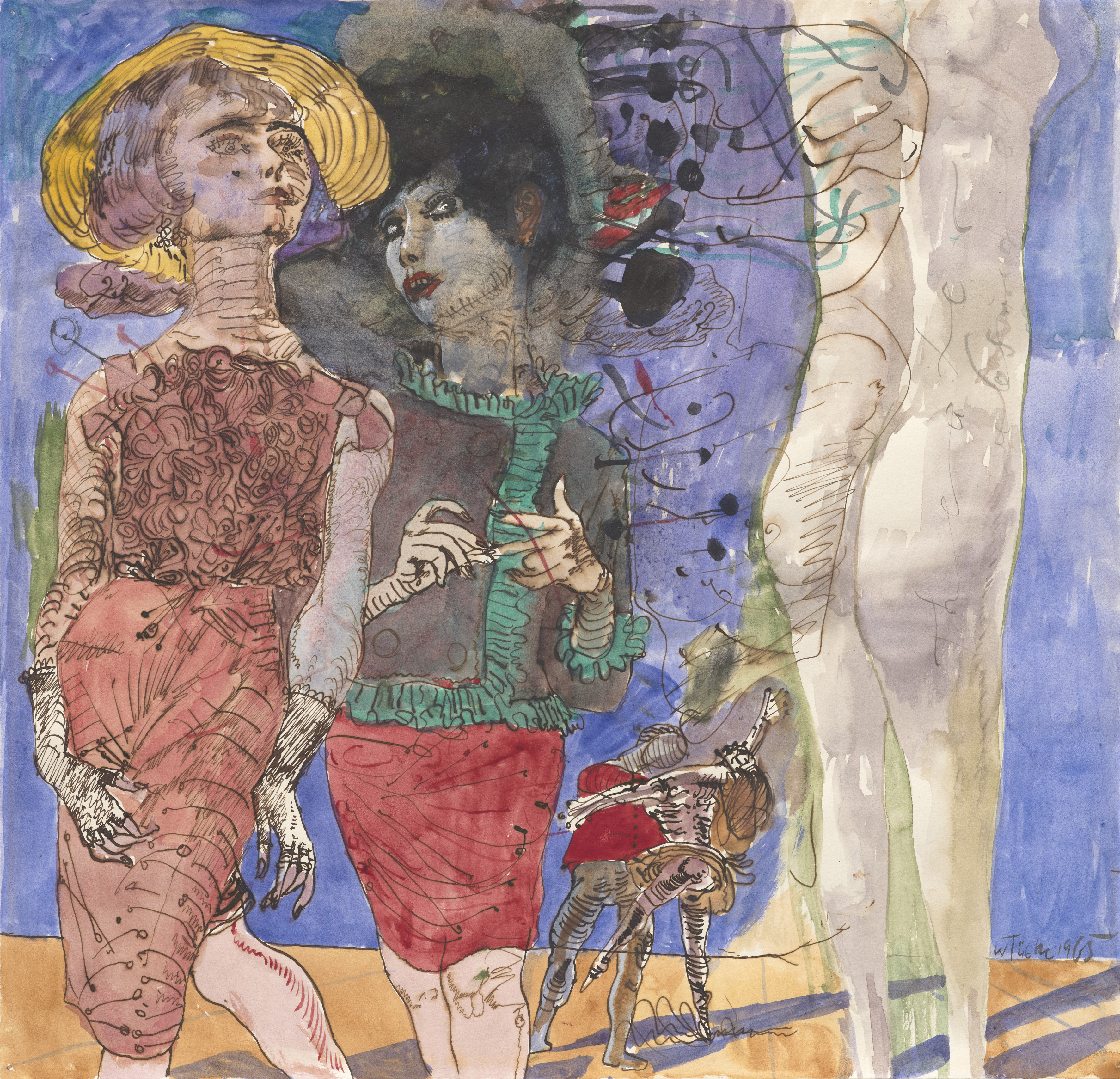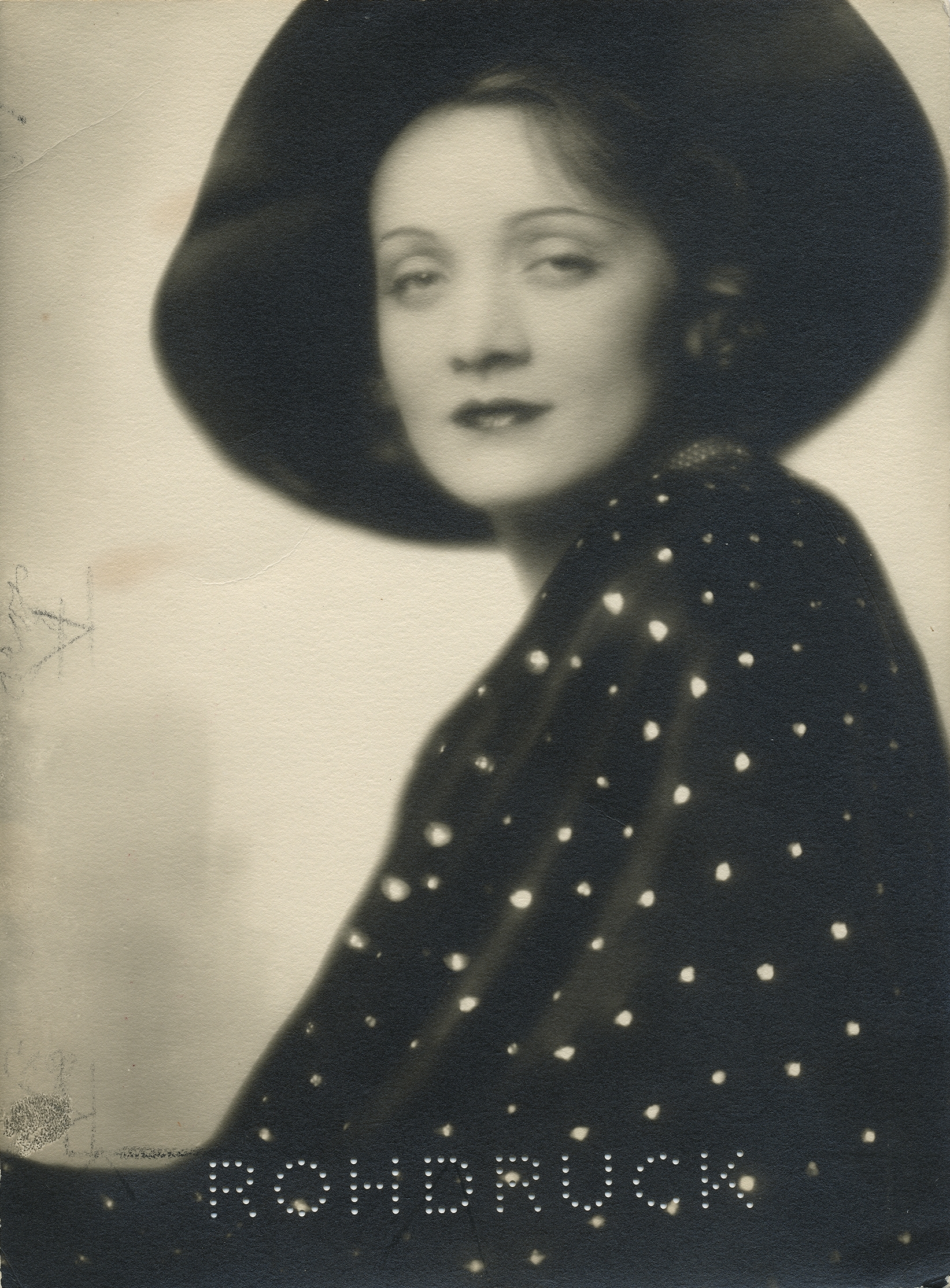Today, roughly 2.2 million people are behind bars in the United States, an increase of 1.9 million since 1972. We have the world’s largest prison population—with one-quarter of its prisoners but just 5 percent of the total population … It’s a system marred by vast racial disparities—one that stigmatizes and targets young black men for arrest at a young age, unfairly punishes communities of color, burdens taxpayers and exacts a tremendous social cost.
—Southern Poverty Law Center
I have completed in excess of twenty self-help groups, therapy programs, and counseling. However, the one thing that completely changed my life was learning art.
—Artist, inmate, and CBA participant, CIM
Our small group walks across the vast prison yard to the gym, chatting casually and remarking on the heat in Chino. Among the seven teaching artists present are students and alumni of the Art Department at California State University, San Bernardino (CSUSB), where I am on the faculty and began the Community-based Art program three years ago. As on each Friday, a correctional officer escorts us to the large, well-used gym and remains with us for the duration of class. Inside, between the basketball courts and a wall of newly painted murals lining the room’s opposite end, a dozen or so participants (inmates) have begun setting up for class. After informal greetings, our teachers slide into action, helping with tables, arranging chairs, and counting out supplies.
More men begin to file in and soon five simultaneous seminars, each with about twelve participants, are up and running. It is the beginning of a ten-week session that includes Printmaking, Art History and Critique, Painting and Drawing, Paper Crafts, and Creative Writing courses. As I pass by the Art History class, the slide projected on the concrete wall reads “Institutional Critique.” The class and two co-instructors, an undergraduate and a graduate student, are posing questions for the students to reflect on and discuss in understanding this approach to art.
Despite the highly institutionalized setting of the prison and our home base in another of the state’s largest institutions, the CSU, the conversation is not ironic. This lesson is one in a series introducing approaches to modern and contemporary art—abstract expressionism, street art, Conceptual art, performance—intended both to educate about art history and to demonstrate to participants, many of them self-taught artists, the ways that they are part of a larger story of art.
At CSUSB, I oversee the undergraduate Visual Studies program and teach courses in Art History, Studio Art, and the Masters of Fine Art program. Community-based Art (CBA) began as an outgrowth of a curriculum redesign that I initiated shortly after joining the Art faculty in 2011. One of my goals was to give students real-world opportunities for collaborative learning through teaching and public practice. We began with two community partners but the combined enthusiasm of students, community groups, and the university has fuelled rapid growth over three years. Currently, our teaching artists facilitate weekly art programming at three state prisons and two community sites and run regular workshops and programming at other community sites, which vary and include shelters for teens, an after-school program at a public housing workshop, and a low-income senior center. In 2015, two grants—from the CSUSB Office of Student Research and from the California Department of Corrections and Rehabilitation—allowed us to form a CBA leadership team consisting of the student Site Leads from each community location that meets weekly to discuss our ongoing work.
Three of my courses are directly tied to CBA as preparation and participation, but all of my classes address the ways that social, cultural, and economic forces impact access to art and, with that, who defines art and the relationship between art and power. Students often tell me they can’t answer my questions easily and, despite my empathy at their grappling, I am also pleased at the depth of their consideration; there are no easy answers to these questions.
We look, examine, discuss, read, and wonder, similar to what is done in classrooms at universities across the country, but then we do something else. We change our ideas by changing our surroundings. We go out and talk with people outside of our own institutional setting and co-create spaces for learning. In the university and onsite, we continue to grow our understandings and question our own and others’ biases and assumptions about identity, art, and community.
There are plenty of preconceived ideas about students, public education, prisons, and inmates—many of them negative—but being a state school in an underserved (and currently bankrupt) city can be a benefit as much as it is a challenge. For example, among our group are teaching artists, staff, and volunteers whose friends or family have been correctional officers and others of us who know people who are incarcerated, lending our group a level of empathy and understanding that might not be apparent in organizations with fewer connections to the community where they work. Seventy percent of those who graduate from CSUSB are the first in their families to graduate from college. Often, students overcome sociocultural, economic, and personal barriers to get to the university and many bring a real desire to make a difference. From my own experience, I have found that our students exhibit maturity and poise, even in difficult situations, and are creative problem solvers.
CBA facilitates art-making at sites in the local community that don’t otherwise have access to it. But the fact that we work with people who are poor or vulnerable or “at-risk” doesn’t automatically make us community-based; so what does? Teachers work together to create structures that are flexible enough to fit a diversity of participants’ needs and interests but firm enough to provide support in differing and often institutional environments, each with unique benefits and challenges. This approach requires asking for a lot of feedback and establishing a physical and psychological space for people to give genuine responses. In this way, CBA is of and for the community. We learn to collaborate with participants by continually asking questions, listening, talking, evaluating, adjusting, and then listening some more. In just three years, it has grown organically from dozens to hundreds of monthly participants, from two to as many as ten community partner sites, and from five to as many as twenty-five regular teaching artists each quarter. Being authentically community-based is inherently messy and complex, but it is also deeply rewarding; every day is new and every person that is involved is as important as the next.
Other programs bring art to correctional populations—especially with the recent resurgence of attention and funding—but ours has a focus on nonhierarchical pedagogy and mutual learning, which begins on campus in our Visual Studies courses and in the graduate program, but evolves substantially with the ongoing participation in CBA by students, alumni, participants, and members of the university and larger community. The processes of communication, self-expression, and the reflective development of self are as important to our curricula and teaching process as technique, aesthetics, and knowledge of art history.
Back at CIM, talk in the Art History class turns to early works by the late Chris Burden. One participant says, “I think he’s pushing the edge. He wants to do something that no one has done before.” Another responds, “Everybody knows there’s beauty in the world, the birds and all, but he’s going the other way and saying, there’s beauty in death.”
At the next table, approximately fifteen men in prison-issue blue uniforms hunker over plastic tables, twisting and folding small bits of colorful tissue paper. The co-facilitators, a university student and an inmate, walk around the table checking in, answering questions, and helping out as the men, with unwavering attention, aim to follow the directions provided for making a new flower, a daisy. I notice a man hand a yellow flower to the inmate co-facilitator. He pauses to smile and tuck it in his pocket before swiftly returning to walking a participant through a tricky step in the process.
On that day, I had a great visit but was feeling worn down by a recent hiccup in the continual search for funding to keep our work going and the usual onslaught of little logistical headaches that come from working in institutions. After a while, I sat down in a plastic chair in the writing class and a participant looked at me and smiled warmly. “Look around,” he said. “You’re doing good work. Don’t stress.” Yes, he is an inmate. And he is also a writer and artist, and, on that day, a wise counselor.
All the categories that we think define who and what we are can be challenged and, in CBA, we see them not only challenged but changed and shifted and traded, revealing the full spectrum of what an individual can be, to ourselves, our communities, and the world. In this program, students are also skilled and dedicated teachers with the chance to share and expand on their own experiences as well as what they learn at the university in art, education, and activism. Professional artists are volunteers, donating their time to give guest lectures in our prison program, similar to the guest lecture program on campus—but again with differences that only a drastic change in setting can illuminate. Individuals that are incarcerated are also, simultaneously, focused and dedicated students and innovative artists, often dealing with much bigger challenges than artists face on the outside. One CBA participant told us, “I remember walking back to my building with the flowers in my hands and being taunted and bullied by others because I chose to learn instead of hanging out on the yard and doing nothing. The ridicule only increased my wanting to excel in art.”
Personal commitment is felt by participants and teachers alike. CBA teaching artist Matt McMilon described his experience by saying, “[T]he number one thing I have learned … would be that each and every person should have the right to creative expression. It is deeply healing and fosters positive personal growth. This experience has changed me as an educator in that it makes me want to continue fighting for equality in the classroom and beyond.” In the current debt-fueled state of art education at the graduate and postgraduate level, it is easy to muddle the argument for the right to creative expression. Jessica Agustin, a CSUSB student and CBA site leader at the Chino women’s prison, remarked on the clarifying effects the program had on her: “CBA breaks down elitist notions of who can study or make art and makes it equal for everyone. The fact that I can make art accessible and relatable to everyone regardless of who they are makes teaching feel like an activist effort.”
—Annie Buckley

